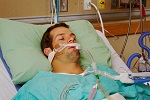
For intensive care doctors, covid-nineteen offers an eerily similar look at how doctors sixty years ago fought to save patients from another viral disease, polio. And this shared experience is poignant because that's when intensive care medicine was born, thanks to a Danish doctor.
Bj'rn Ibsen had a bold idea for giving patients air using mechanical ventilation, the precursor to the modern ventilator. Polio can paralyze chest muscles making it hard to breathe. At the time, patients were placed inside negative pressure boxes while their heads stuck out in order to allow their chest to relax, expand, and improve breathing. They were known as iron lungs but some people still died from respiratory failure.
Ibsen had a better idea. He wanted to apply not negative but positive air pressure directly into the lungs then allow the body to exhale normally. To do this, they made a cut at the neck, inserted a tube into the windpipe and attached a rubber bag to be pumped manually. The bag was attached to a tank of fifty percent oxygen and nitrogen, and a soda lime container removed carbon dioxide.
If carbon dioxide isn't dispelled, acid can build up in the blood and cause organ failure. Turns out, this killed some polio patients, but Ibsen's invention solves that problem. Today's ventilators are able to deliver the right amount of air and pressure and they save lives.
More Information
The outbreak that invented intensive care
A heroic community effort at a daring hospital saved lives, led to today's ventilators and revolutionized medicine ' it holds lessons for our times...
The Surprisingly Long History of the Ventilator, the Machine You Never Want to Need
For doctors, resorting to a ventilator is an extreme measure, used when a patient's lungs cannot supply enough oxygen on their own. Ventilators can also give a patient's body time to rest when breathing is difficult, and allow doctors to more easily remove lung secretions or deliver medications directly to the respiratory system...
The physiological challenges of the 1952 Copenhagen poliomyelitis epidemic and a renaissance in clinical respiratory physiology
The 1952 Copenhagen poliomyelitis epidemic provided extraordinary challenges in applied physiology. Over 300 patients developed respiratory paralysis within a few weeks, and the ventilator facilities at the infectious disease hospital were completely overwhelmed. The heroic solution was to call upon 200 medical students to provide round-the-clock manual ventilation using a rubber bag attached to a tracheostomy tube...